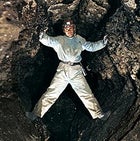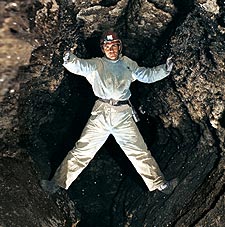No well-wishers were on hand last year to greet the 11 Russian and Ukrainian cavers who pulled themselves out of Krubera Cave, high in the Republic of Georgia, and into the history books. Twelve days earlier, when the team had last stood topside here on the Arabika Massif, they'd faced a cold and dry mountain. Now a blizzard hammered the slopes, and the only thing welcoming the party was the bitter wind and the crushing realization that, with no helicopter pickup in sight, they would have to walk out. Pausing briefly to reconnoiter, the groupÔÇöwhich had spent almost two weeks rappelling down tight, damp corridors and blasting rubble-clogged passages to descend deeper into the earth than anyone had gone beforeÔÇöbegan the trek through waist-deep snow, bound for the tree line. Halfway there, an avalanche released and overwhelmed the man in front, Anatolij Povjakalo, who had turned 18 while in the cave. The team pulled him out unharmed.
 Ukrainian Speleological Association member Yevgeni Kislistim straddles a passage inside Ozernaja Cave, in Western Ukraine
Ukrainian Speleological Association member Yevgeni Kislistim straddles a passage inside Ozernaja Cave, in Western Ukraine
Today, the episode stands as a bitter metaphor for life with the Cavex Cave Exploration Society and Ukrainian Speleological Association (UKSA), an elite joint team in which predilections for extreme cold, cramped quarters, and the dark are requirements for joining, and where expeditions, like everyday life in the former Soviet Republics, amount to one misery piled on top of another. Yet despiteÔÇöor perhaps because ofÔÇösuch misfortunes, the 30-odd members of Cavex, led by 45-year-old Alexander Klimchouk, are bar none the most skilled deep-cave explorers on earth, and the undisputed leaders of a worldwide drive to reach the speleological equivalent of the four-minute mileÔÇöa point 2,000 meters, or a mile and a quarter, below ground. Though the team's record-breaking 1,710-meter push into Krubera Cave last January brought them tantalizingly close to that coveted mark, it was but one expedition in what will eventually be an eight-year project, christened “The Call of the Abyss,” designed to bring them closer to their goal. This January, the drive for depth will take them into the little-explored Skaljarevo Brezno Cave in Slovenia's Julian Alps, where the winter freeze will once again reduce the danger of an underground flash flood, and where blasting through a blocked passage will lead them, they hope, to the mother of all deep-cave pits.
When the men and women of Cavex and the UKSA pass the 2,000-meter markÔÇöand few doubt that they willÔÇöKlimchouk, the founder of both groups and president of Cavex, will likely be the first man below the line. “My expectations are quite high; we have really strong people,” he says. “My life experience is, if you have a very strong desire, your goals usually happen.” Born in Odessa, Klimchouk, a senior scientist with the Ukraine's National Academy of Sciences, has spent most of his life plumbing the depths. Like athletes in the famous Eastern Bloc training camps of the Cold War era, many of his society's members, including his son Oleg, now 26, a construction worker, and Kiev-based Nikolaj Solovjov, 44, were first sent underground as children, some as early as age five. After decades of mentoring, the young explorers (most began deep caving in their twenties) have since mastered the most complex vertical-caving techniques, including cave rescue, rope work, cave diving, rock cutting, surveying, scientific sampling, and blasting. (Widening passages with gunpowder, while frowned upon by conservationists, remains a common practice around the world.) Now, as all-star players in the caving world's major leagues, they are eminently qualified to tackle the ultimate underground endurance event.
“The amount of training, skill, technical experience, and difficulty of logistics make descending a 2,000-meter cave akin to a summit attempt of Everest,” says Hazel Barton, a University of Colorado microbiologist and a board member of the Huntsville, Alabama-based National Speleological Society. “It takes a lot of mental strength to accomplish these long underground expeditions,” she adds.
Like 8,000-meter peaks, deep cavesÔÇögenerally defined as those bottoming out beyond 1,000 metersÔÇöare confined to small, not easily accessible geographic regions. Beyond Central Asia, many lie in the Italian and Austrian Alps, southern Mexico, and parts of Spain. Further, as is the case with the Himalayas, the harsh physical challenges of winter trips to these depths make them inaccessible to all but the most fit and organized. As caves plunge below the realm of weekend exploration, the mercury drops close to freezing, boulder chokes demand more potentÔÇöand more carefully placedÔÇöexplosives, and passageways can narrow into squeezes known as “chest compressors” that require a total exhalation to pass through. So far, no one on the Call of the Abyss team has died or suffered serious injury, but the stamina and competence needed to negotiate deep caves grow geometrically the farther a team descends. But since such trips involve spending days and sometimes weeks working and bivouacking underground in close quarters, team solidarity and trust are the most important requirements.
Little wonder that depth records are so rare. The first, 140 meters, was set in 1723 by an engineer simply known as Nagel in what is now the Czech Republic. The record stood, remarkably, for more than 200 years, until cavers in France dropped below 500 meters in 1944. Since then, the pace of exploration has quickened somewhatÔÇö1,000 meters fell in 1956 and 1,500 meters in 1983ÔÇöbut progress in the past two decades has been measured by smaller and smaller increments, usually less than 20 meters at a time.
That is, until the Call of the Abyss teamÔÇöpossibly riding a nicotine high from their strong Russian cigarettesÔÇösmashed the record by pushing an extra 80 meters down into Krubera in one go. Now, in the first weeks of January, a Cavex team will tackle the Kanin Massif in Slovenia's Julian Alps, an area of limestone sinkholes and shafts that they have been scouting since 1996. With funding from the Kiev-based construction firm Paritet, the team will descend Skaljarevo Brezno Cave to 900 meters and blast through a boulder choke. Beyond, they hope, they'll find another record-breaking pit.
Should Brezno run shallow, Klimchouk and the Call of the Abyss organizers have already scheduled more summer expeditions to Krubera and Turkey's Aladaglar Massif, where they plan to conduct dye tests in underground rivers. But cavers, a famously superstitious lot, are reluctant to lay odds on whether these attempts will pay off for The Call of the Abyss. “It's very bad form to discuss depth too openly,” says Yury Kasjan. “If you assume you're going to break the record, and bring along too much equipment, the cave will be scared and stop.” We can assume, however, that these cavers never will.


